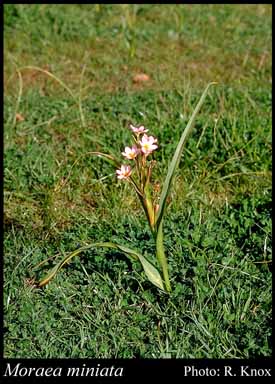- Reference
- Bot.Repos. 5,Pl.404 (1804)
- Conservation Code
- Not threatened
- Naturalised Status
- Alien to Western Australia
- Name Status
- Current
Cormous, perennial, herb, to 0.5 m high. Fl. pink & yellow & orange, Jul to Nov. Brown sandy loam, red sandy clay, grey sand or sandy clay, granite, limestone. Undulating hills and flats, pastureland.

Distribution
- IBRA Regions
- Avon Wheatbelt, Esperance Plains, Jarrah Forest, Mallee, Swan Coastal Plain.
- IBRA Subregions
- Fitzgerald, Katanning, Merredin, Northern Jarrah Forest, Perth, Western Mallee.
- Local Government Areas (LGAs)
- Beverley, Capel, Cockburn, Corrigin, Cuballing, Dardanup, Kulin, Merredin, Moora, Narrogin, Northam, Perenjori, Pingelly, Quairading, Ravensthorpe, Swan, Yilgarn, York.
Management Notes (for the Swan NRM Region)
General Biology. Growth form. Geophyte. Life form. Annually renewed corm. Reproduction. Primarily cormels on stem and base, occasionally offsets. Dispersal. Water, soil, birds, Cyclone Alby. Time to first flowering. 2-3 years. Seedbank persistence. Cormels can persist for 8 years. Fire response. Generally survives fire.
Notes. Two leaf cape tulip does not produce viable seed. Each year a large number of small cormels are produced in each leaf axil and around developing corms at the base of the plant. All parts of the plant are toxic to stock.
Additional information. Origin. Southern Africa. History of use/introduction. Garden escape. Similar exotic species. Moraea flaccida.
Suggested method of management and control. Spot spray metsulfuron methyl 0.2 g/15 L or chlorsulfuron 0.2 g/15 L + Pulse® or 2.5-5 g/ha + Pulse® or 2,2 DPA 55 g/10 L + Pulse®. Apply just on flowering at corm exhaustion. Physical removal can result in spread of cormels. Read the manufacturers' labels and material safety data sheets before using herbicides. For further information consult the Australian Pesticides and Veterinary Medicines Authority to determine the status of permits for your situation or state.
Management Calendar
| Calendar Type | Jan | Feb | Mar | Apr | May | Jun | Jul | Aug | Sep | Oct | Nov | Dec | Comments |
|---|---|---|---|---|---|---|---|---|---|---|---|---|---|
| Dormant | Y | Y | Y | Y | |||||||||
| Active Growth | Y | Y | Y | Y | Y | Y | Y | Y | |||||
| Flowering | Y | Y | Y | Y | |||||||||
| Optimum Treatment | Y | Y | Y |
Legend: Y = Yes, regularly, O = Occasionally, U = Uncertain, referred by others but not confirmed.
References
- Agriculture Protection Board of Western Australia (1988) A summary of the proceedings of cape tulip workshops. August 1988, Perth.
- Brown, K. & Brooks, K. (2002) Bushland Weeds: A Practical Guide to their Management. Environmental Weeds Action Network, Greenwood.
- Brown, K. & Paczkowska, G. (2006) Managing weeds in bushland: Cape Tulip (Moraea flaccida & M. miniata). Department of Environment and Conservation Brochure.
- Goldblatt, P. (1986) The Moraeas of Southern Africa. A systematic monograph of the genus in South Africa, Lesotho, Swaziland, Transkei, Botswana, Namibia and Zimbabwe. Annals of Kirstenbosch Botanic Gardens, 14.
- Hussey, B.M.J., Keighery, G.J., Dodd, J., Lloyd, S.G. & Cousens, R.D. (2007) Western Weeds. A guide to the weeds of Western Australia. 2nd Edition. The Plant Protection Society of Western Australia, Victoria Park.
- Parsons, W.T. & Cuthbertson, E.G. (2001) Noxious weeds of Australia. 2nd Edition. CSIRO Publishing, Collingwood.